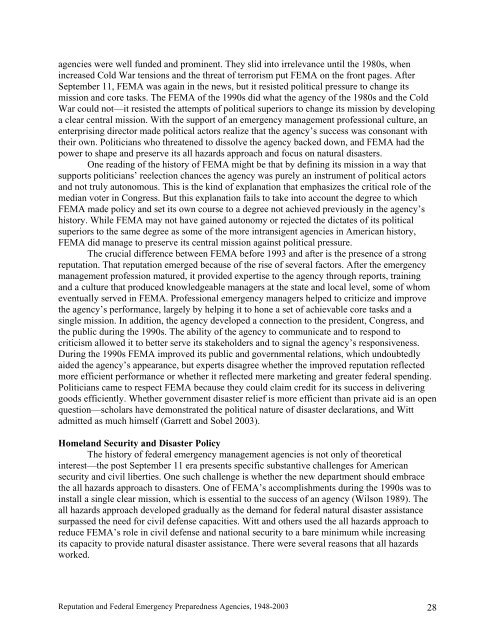Reputation and Federal Emergency Preparedness Agencies, 1948
Reputation and Federal Emergency Preparedness Agencies, 1948
Reputation and Federal Emergency Preparedness Agencies, 1948
You also want an ePaper? Increase the reach of your titles
YUMPU automatically turns print PDFs into web optimized ePapers that Google loves.
agencies were well funded <strong>and</strong> prominent. They slid into irrelevance until the 1980s, when<br />
increased Cold War tensions <strong>and</strong> the threat of terrorism put FEMA on the front pages. After<br />
September 11, FEMA was again in the news, but it resisted political pressure to change its<br />
mission <strong>and</strong> core tasks. The FEMA of the 1990s did what the agency of the 1980s <strong>and</strong> the Cold<br />
War could not—it resisted the attempts of political superiors to change its mission by developing<br />
a clear central mission. With the support of an emergency management professional culture, an<br />
enterprising director made political actors realize that the agency’s success was consonant with<br />
their own. Politicians who threatened to dissolve the agency backed down, <strong>and</strong> FEMA had the<br />
power to shape <strong>and</strong> preserve its all hazards approach <strong>and</strong> focus on natural disasters.<br />
One reading of the history of FEMA might be that by defining its mission in a way that<br />
supports politicians’ reelection chances the agency was purely an instrument of political actors<br />
<strong>and</strong> not truly autonomous. This is the kind of explanation that emphasizes the critical role of the<br />
median voter in Congress. But this explanation fails to take into account the degree to which<br />
FEMA made policy <strong>and</strong> set its own course to a degree not achieved previously in the agency’s<br />
history. While FEMA may not have gained autonomy or rejected the dictates of its political<br />
superiors to the same degree as some of the more intransigent agencies in American history,<br />
FEMA did manage to preserve its central mission against political pressure.<br />
The crucial difference between FEMA before 1993 <strong>and</strong> after is the presence of a strong<br />
reputation. That reputation emerged because of the rise of several factors. After the emergency<br />
management profession matured, it provided expertise to the agency through reports, training<br />
<strong>and</strong> a culture that produced knowledgeable managers at the state <strong>and</strong> local level, some of whom<br />
eventually served in FEMA. Professional emergency managers helped to criticize <strong>and</strong> improve<br />
the agency’s performance, largely by helping it to hone a set of achievable core tasks <strong>and</strong> a<br />
single mission. In addition, the agency developed a connection to the president, Congress, <strong>and</strong><br />
the public during the 1990s. The ability of the agency to communicate <strong>and</strong> to respond to<br />
criticism allowed it to better serve its stakeholders <strong>and</strong> to signal the agency’s responsiveness.<br />
During the 1990s FEMA improved its public <strong>and</strong> governmental relations, which undoubtedly<br />
aided the agency’s appearance, but experts disagree whether the improved reputation reflected<br />
more efficient performance or whether it reflected mere marketing <strong>and</strong> greater federal spending.<br />
Politicians came to respect FEMA because they could claim credit for its success in delivering<br />
goods efficiently. Whether government disaster relief is more efficient than private aid is an open<br />
question—scholars have demonstrated the political nature of disaster declarations, <strong>and</strong> Witt<br />
admitted as much himself (Garrett <strong>and</strong> Sobel 2003).<br />
Homel<strong>and</strong> Security <strong>and</strong> Disaster Policy<br />
The history of federal emergency management agencies is not only of theoretical<br />
interest—the post September 11 era presents specific substantive challenges for American<br />
security <strong>and</strong> civil liberties. One such challenge is whether the new department should embrace<br />
the all hazards approach to disasters. One of FEMA’s accomplishments during the 1990s was to<br />
install a single clear mission, which is essential to the success of an agency (Wilson 1989). The<br />
all hazards approach developed gradually as the dem<strong>and</strong> for federal natural disaster assistance<br />
surpassed the need for civil defense capacities. Witt <strong>and</strong> others used the all hazards approach to<br />
reduce FEMA’s role in civil defense <strong>and</strong> national security to a bare minimum while increasing<br />
its capacity to provide natural disaster assistance. There were several reasons that all hazards<br />
worked.<br />
<strong>Reputation</strong> <strong>and</strong> <strong>Federal</strong> <strong>Emergency</strong> <strong>Preparedness</strong> <strong>Agencies</strong>, <strong>1948</strong>-2003 28

















